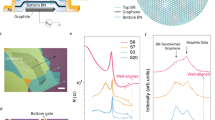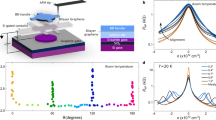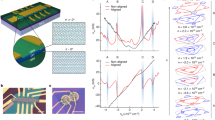Abstract
In van der Waals (vdW) heterostructures consisting of atomically thin crystals layered on top of one another, lattice mismatch and rotation between the layers can result in long-wavelength moiré superlattices. These moiré patterns can drive notable band structure reconstruction of the composite material, leading to a wide range of emergent phenomena including superconductivity1,2,3, magnetism4, fractional Chern insulating states5 and moiré excitons6,7,8,9. Here, we investigate devices consisting of monolayer graphene encapsulated between two crystals of boron nitride (BN), in which the rotational alignment of all three components is controlled. We find that bandgaps in the graphene arising from perfect rotational alignment with both BN layers can be modified considerably depending on whether the relative orientation of the two BN layers is 0° or 60°, suggesting a tunable transition between the absence or presence of inversion symmetry in the heterostructure. Small deviations (<1°) from perfect alignment of all three layers leads to coexisting long-wavelength moiré potentials, resulting in a highly reconstructed graphene band structure featuring multiple secondary Dirac points. Our results demonstrate that the interplay between multiple moiré patterns can be utilized to controllably modify the symmetry and electronic properties of the composite heterostructure.
This is a preview of subscription content, access via your institution
Access options
Access Nature and 54 other Nature Portfolio journals
Get Nature+, our best-value online-access subscription
$29.99 / 30 days
cancel any time
Subscribe to this journal
Receive 12 print issues and online access
$259.00 per year
only $21.58 per issue
Buy this article
- Purchase on Springer Link
- Instant access to full article PDF
Prices may be subject to local taxes which are calculated during checkout




Similar content being viewed by others
Data availability
The datasets generated during and/or analysed during the current study are available from the corresponding author on reasonable request.
References
Cao, Y. et al. Unconventional superconductivity in magic-angle graphene superlattices. Nature 556, 43–50 (2018).
Yankowitz, M. et al. Tuning superconductivity in twisted bilayer graphene. Science 363, 1059–1064 (2019).
Chen, G. et al. Signatures of tunable superconductivity in a trilayer graphene moiré superlattice. Nature 572, 215–219 (2019).
Sharpe, A. L. et al. Emergent ferromagnetism near three-quarters filling in twisted bilayer graphene. Science 365, 605–608 (2019).
Spanton, E. M. et al. Observation of fractional Chern insulators in a van der Waals heterostructure. Science 260, 62–66 (2018).
Seyler, K. L. et al. Signatures of moiré-trapped valley excitons in MoSe2/WSe2 heterobilayers. Nature 567, 66–70 (2019).
Tran, K. et al. Evidence for moiré excitons in van der Waals heterostructures. Nature 567, 71–75 (2019).
Jin, C. et al. Observation of moiré excitons in WSe2/WS2 heterostructure superlattices. Nature 567, 76–80 (2019).
Alexeev, E. M. et al. Resonantly hybridized excitons in moiré superlattices in van der Waals heterostructures. Nature 567, 81–86 (2019).
Yankowitz, M., Ma, Q., Jarillo-Herrero, P. & LeRoy, B. J. van der Waals heterostructures combining graphene and hexagonal boron nitride. Nat. Rev. Phys. 1, 112–125 (2019).
Yankowitz, M. et al. Emergence of superlattice Dirac points in graphene on hexagonal boron nitride. Nat. Phys. 8, 382–386 (2012).
Ribeiro-Palau, R. et al. Twistable electronics with dynamically rotatable heterostructures. Science 361, 690–693 (2018).
Yankowitz, M. et al. Dynamic band-structure tuning of graphene moiré superlattices with pressure. Nature 557, 404–408 (2018).
Forsythe, C. et al. Band structure engineering of 2D materials using patterned dielectric superlattices. Nat. Nanotechnol. 13, 566–571 (2018).
Hunt, B. et al. Massive Dirac fermions and Hofstadter butterfly in a van der Waals heterostructure. Science 340, 1427–1430 (2013).
Cao, Y. et al. Correlated insulator behaviour at half-filling in magic-angle graphene superlattices. Nature 556, 80–84 (2018).
Wang, L. et al. New generation of moiré superlattices in doubly aligned hBN/graphene/hBN heterostructures. Nano Lett. 19, 2371–2376 (2019).
Chari, T., Riberio-Palau, R., Dean, C. R. & Shepard, K. Resistivity of rotated graphite–graphene contacts. Nano Lett. 16, 4477–4482 (2016).
Eckmann, A. et al. Raman fingerprint of aligned graphene/h-BN superlattices. Nano Lett. 13, 5242–5246 (2013).
Wang, L. et al. Evidence for a fractional fractal quantum Hall effect in graphene superlattices. Science 350, 1231–1234 (2015).
Woods, C. R. et al. Commensurate–incommensurate transition in graphene on hexagonal boron nitride. Nat. Phys. 10, 451–456 (2014).
Chen, Z.-G. et al. Observation of an intrinsic bandgap and Landau level renormalization in graphene/boron-nitride heterostructures. Nat. Commun. 5, 4461 (2014).
Wang, E. et al. Gaps induced by inversion symmetry breaking and second-generation Dirac cones in graphene/hexagonal boron nitride. Nat. Phys. 12, 1111–1115 (2016).
Song, J. C. W., Shytov, A. V. & Levitov, L. S. Electron interactions and gap opening in graphene superlattices. Phys. Rev. Lett. 111, 266801 (2013).
Bokdam, M., Amlaki, T., Brocks, G. & Kelly, P. J. Band gaps in incommensurable graphene on hexagonal boron nitride. Phys. Rev. B 89, 201404(R) (2014).
Moon, P. & Koshino, M. Electronic properties of graphene/hexagonal-boron-nitride moiré superlattice. Phys. Rev. B 90, 155406 (2014).
Wallbank, J. R., Mucha-Kruczynski, M., Chen, X. & Fal’ko, V. I. Moiré superlattice effects in graphene/boron-nitride van der Waals heterostructures. Ann. Phys. 527, 359–376 (2015).
Jung, J., DaSilva, A. M., MacDonald, A. H. & Adam, S. Origin of band gaps in graphene on hexagonal boron nitride. Nat. Commun. 6, 6308 (2015).
San-Jose, P., Gutiérrez-Rubio, A., Sturla, M. & Guinea, F. Spontaneous strains and gap in graphene on boron nitride. Phys. Rev. B 90, 075428 (2014).
Slotman, G. et al. Effect of structural relaxation on the electronic structure of graphene on hexagonal boron nitride. Phys. Rev. Lett. 115, 186801 (2015).
Jung, J. et al. Moiré band model and band gaps of graphene on hexagonal boron nitride. Phys. Rev. B 96, 085442 (2017).
Wang, L. et al. One-dimensional electrical contact to a two-dimensional material. Science 342, 614–617 (2013).
Acknowledgements
We thank R. Ribeiro-Palau, C. Zhang and S. Chen for technical support, as well as J. Jung, M. Koshino and C. Marianetti for helpful discussions. This work was primarily supported by the NSF MRSEC program through Columbia in the Center for Precision Assembly of Superstratic and Superatomic Solids (DMR-1420634). Sample device design and fabrication was partially supported by DoE Pro-QM EFRC (DE-SC0019443). N.R.F. acknowledges support from the Stewardship Science Graduate Fellowship program provided under cooperative agreement number DE-NA0002135. C.R.D. acknowledges the support of the David and Lucile Packard Foundation. K.W. and T.T. acknowledge support from the Elemental Strategy Initiative conducted by the MEXT, Japan and the CREST (JPMJCR15F3), JST.
Author information
Authors and Affiliations
Contributions
N.R.F. and L.M. fabricated the devices. N.R.F. and M.Y. performed the measurements and analysed the data. K.W. and T.T. grew the hBN crystals. C.R.D. and J.H. advised on the experiments. The manuscript was written with input from all authors.
Corresponding authors
Ethics declarations
Competing interests
The authors declare no competing interests.
Additional information
Publisher’s note Springer Nature remains neutral with regard to jurisdictional claims in published maps and institutional affiliations.
Supplementary information
Supplementary Information
Supplementary Sections 1–8, Figs. 1–8, Table 1 and refs. 1–8.
Rights and permissions
About this article
Cite this article
Finney, N.R., Yankowitz, M., Muraleetharan, L. et al. Tunable crystal symmetry in graphene–boron nitride heterostructures with coexisting moiré superlattices. Nat. Nanotechnol. 14, 1029–1034 (2019). https://doi.org/10.1038/s41565-019-0547-2
Received:
Accepted:
Published:
Issue Date:
DOI: https://doi.org/10.1038/s41565-019-0547-2
This article is cited by
-
Higher order gaps in the renormalized band structure of doubly aligned hBN/bilayer graphene moiré superlattice
Nature Communications (2024)
-
Non-identical moiré twins in bilayer graphene
Nature Communications (2023)
-
Thermally stable quantum Hall effect in a gated ferroelectric-graphene heterostructure
Communications Physics (2023)
-
Moiré straintronics: a universal platform for reconfigurable quantum materials
npj 2D Materials and Applications (2023)
-
An anisotropic van der Waals dielectric for symmetry engineering in functionalized heterointerfaces
Nature Communications (2023)



